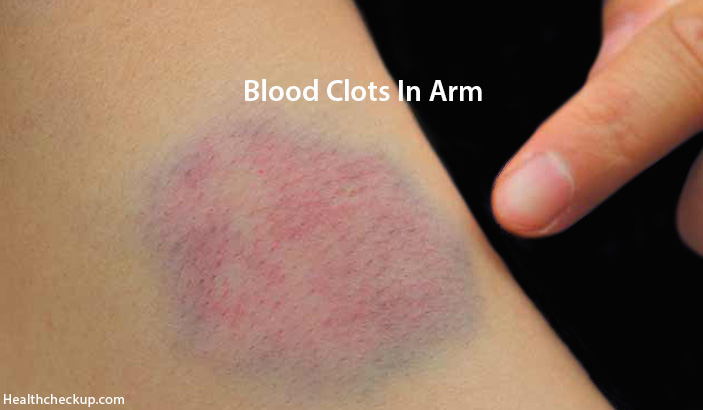We often hear people talking about blood clots but we never understand how harmful it can be. Blood clots can be dangerous at times and most of the people who suffer from a blood clot in arm tend to ignore this fact. A blood clot is a mass of blood that state of which is changed from liquid to something like a slimy gel.
Though it is understood that clotting is a process that is important as it prevents from the loss of blood during an injury, but the clots that form inside of our veins are the ones that do not get dissolved on their own. This condition can be dangerous at times and can also lead to life threatening situations.
When the blood clot is formed inside on the veins of the arm, it can be immobile and such a clot is harmless. But, with time and if not treated properly, it can move and also become dangerous at times. There are cases when the blood clot can break free and can travel via the veins to the heart and the lungs. This can thus get stuck and prevent the flow of blood, causing a medical emergency.
What Does A Blood Clot in Arm Feel like?
When we have a cut, be it a small one or a big one, the components present in the blood come together and they form a clot. This is how bleeding is stopped. There are situations when the blood present in the veins and the arteries tends to form a lump that is on semisolid state and such a clot can cause more damage than good.
When the clots are formed in the veins that are present deep inside our body, the condition is known as the deep vein thrombosis. If the clot occurs in the veins and near to the skin’s surface and causes inflammation, the condition is called as superficial thrombophlebitis. There are blood clots that get dislodged and also travel to other parts in the body and these are known as emboli.
The condition of DVT normally occurs in the veins present in the legs but this can also occur in the arms as well. When such a condition happens in the arms, it is called as the DVT-UE.
Blood Clot in Arm Causes
If you are wondering as to what causes the blood clots in arms, read on to know more. The blood clots are formed in the body when the platelets and various other proteins help blood to form into a semisolid mass. The blood clots that are formed in the arms can be classified as the primary or the secondary clots and this depends on the reason why the blood clot occurred in the first place.
The primary DVT-UE is known to be very rare and this can occur due to Paget-Schroetter syndrome or can be due to idiopathic. In simple terms, there is no cause or a trigger for the occurrence of primary DVT-UE. People who are suffering from effort thrombosis often develop blood clot in the arm and this can occur after any exhausting activity like wrestling or rowing or even after weight lifting.
The secondary DVT-UE is more common and it makes to about 80% of the cases. This condition occurs when something starts to disrupt the vein and this can initiate the clot. Some of the common triggers can be central venous catheters, pace makers and tumors.
Also, a blood clot in arm after blood test is quite common.
Blood Clot in Arm Symptoms
When you know you are having a blood clot in arm, it is quite obvious you will look out for more symptoms. Though the most common place for the occurrence of blood clots in the lower leg, the clots in the arms are common too.
The blood clots in the leg or the arm can have the below mentioned symptoms.
- Swelling in the affected area
- Moderate to severe pain
- Tenderness
- A very warm sensation
- Discoloration where the area tunes into a reddish color.
Also, the symptoms can depend on the clot size and this is one of the main reasons a number of people do not show any symptoms. You might at times have only a minor calf swelling and no pain at all. If the blood clot is large, the above symptoms can be seen.
How to Check for Blood Clot in Arm?
Well, know that we learnt about the causes and the symptoms of blood clot; let us also learn as to how to check for a blood clot that occurs in the arm. If you have undergone a recent surgery, your doctor might watch for signs of any blood clots. In case any are found, they would act upon quickly and treat it. Blood clot in arm after IV is also possible after a surgery or after a long medical procedure.
In case you are at home and you know you have a blood clot, it is advised you take an appointment and visit the doctor as soon as possible. The doctor would start making a physical examination and might even ask you a number of questions about the symptoms and as to how and when they started. After which you might have to take an imaging test.
Most of the times an ultrasound is preferred as it is the fastest as well as the easiest ways to check for the blood clot in the arm. Some of the other tests that can be prescribed by your doctor include a CT scan, an MRI Scan, or even a Contrast venography. All these tests help the doctor understand where the blood clots have formed using the images taken.
Blood Clot in Arm Treatment
Once the diagnosis is complete, the very first goal of the doctor is to stop the growth of the blood clot. He might as well give you medications to relieve you of the symptoms like pain or inflammation. Also, treatment is started so that the clot does not move to the lungs or other body parts. In very rare cases, a surgery to remove a blood clot in the arm is required.
Some of the procedures followed are
Providing Compression in The Arm Sleeve – This is more like a tight sock that can be placed on the arm and this increases the flow of the blood from the hand to the heart.
Medications For Blood Thinning – Blood thinning medications do not actually make the blood thin, but they prevent blood clot formations in the body. They also prevent the growth of the existing blood clots.
In cases where the treatments do not provide a solution or when the blood clot is very big, the doctor might suggest a surgery.
If you have any of the above mentioned symptoms, it is good to seek medical help immediately. Though a blood clot in arm might seem like a harmless condition, you really do not want to rule out the chances of life threatening medical condition.
Medically Reviewed By

Maanasi specializes in health topics including diet and nutrition. A mother of an untiring seven year old, she enjoys nurturing her love affair with English. She is often found nestled with a book, plopped against a dozen pillows, smiling away at the brink of finishing yet another book of the many dozens, that adorn the shelves of her Mini Library!








